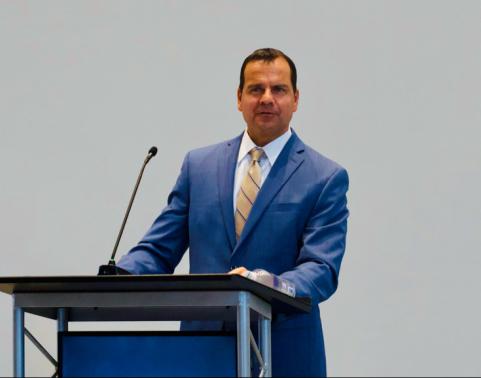PEO EIS Leaders Discuss Unified Network Support at AFCEA TechNet Augusta

PEO EIS Program Executive Officer Ross Guckert and leaders from EIS’ Networks, Cyber and Services portfolio descended on Augusta, Georgia the week of Aug. 15 to participate in AFCEA TechNet Augusta. The annual event provides a forum for government, industry and academia to discuss the intricacies of the cyber domain — this year in alignment with the theme of “Designing and Deploying a Unified Network.”
During his PEO keynote on Aug. 16, Guckert provided an update on EIS’ support for the Army’s Unified Network, which aims to accelerate the transition from separate networks into one network that supports the data-centric Army, increases network security, allows common network visibility and provides end-to-end connectivity.
To support Unified Network Operations, EIS is closely collaborating with the Army Network Enterprise Technology Command and PEO Command Control Communications – Tactical (PEO C3T) to ensure a common understanding and approach, said Guckert. EIS also is participating in network capability portfolio reviews with the Under Secretary of the Army in four areas: Department of Defense Information Network – Army (DODIN-A) operations, common services infrastructure, common transport and common operating environment. These briefings are designed to help build the case for executing on everything in the Army’s Unified Network Plan.
EIS is supporting three aspects of that plan, said Guckert. The first is Identity, Credential and Access Management (ICAM). EIS is working with the Army Deputy Chief of Staff G-6 to execute its road map for basic ICAM capabilities, as well as collaborating with PEO C3T, the Army Cyber Center of Excellence and other partners on a requirements definition package for a comprehensive ICAM solution based on a managed service model.
The second part of EIS’ Unified Network Plan support involves Secret Internet Protocol Router Network (SIPRNet) modernization. This past spring, EIS hosted a SIPRNet Industry Day to gather information for a solicitation, which is expected to be released in the near future. The intent is to modernize the Army’s classified and non-classified networks into one gray network that provides Soldiers with unified capabilities in disconnected environments.
Finally, EIS is supporting the voice modernization piece of the Unified Network Plan. Specifically, EIS is attempting to reduce the Army’s overall phone count, regionalize existing Voice over IP capabilities, implement a regional modernization approach and decommission the time division multiplexing infrastructure. EIS is updating the Army chief information officer and G-6 regularly on progress made.
“We anticipate that solicitation — Voice Modernization 2.0 — to be released later this year,” said Guckert, adding that EIS’ biggest need from industry is for synchronization solutions instead of individual tools.
In alignment with the Assistant Secretary of the Army for Acquisition, Logistics and Technology’s priority to improve and accelerate software acquisition, EIS is planning to model some of the practices of its Defensive Cyber Operations (DCO) project management office. DCO’s flexible requirements, flexible contacting approaches and flexible funding models are “a model not just for the Army — but for DOD,” said Guckert.
“They’re the pathfinders for DOD, single-handedly changing the face of rapid acquisition,” he added.
Before wrapping up his presentation, Guckert turned to the topic of data and what EIS is doing to support a data-centric environment for the Army. He highlighted some of Army Vantage’s accomplishments in this regard, including its recent usage by the XVIII Airborne Corps to modernize deployments by transforming manual processes into data-centric ones.
The Army is drafting a requirement for the data fabric/mesh architecture connecting the tactical and enterprise networks, said Guckert.
“We welcome industry’s input on how best to do that,” he said.
Guckert also encouraged industry partners to become familiar with key Army strategic documents involving data centricity, including the Army Data Plan, Army Cloud Plan, Army Digital Modernization Strategy and Army Unified Network Plan.
Following the PEO keynote, leaders from EIS’ DCO, Integrated Enterprise Network and Enterprise Services portfolios provided updates on their activities and shared some best practices for working with industry.
Related News
-
Onedia James: a logistician and leader with a family legacy of service
April 22, 2025Onedia James recently stepped into the role of acting deputy project manager for Army Data and Analytics Platforms (ARDAP) at U.S. Army Program Executive Office (PEO) Enterprise, where she helps oversee and support the data portfolio’s four programs. -
PEO Enterprise’s new PL Digital Market reimagines IT product/service procurement
April 2, 2025FORT BELVOIR, Va. – U.S. Army Program Executive Office (PEO) Enterprise today announced the launch of the Product Lead (PL) Digital Market, which replaces PL Computer Hardware, Enterprise Software and Services (CHESS), effective Apr. 2, 2025. -
Two vastly different Army programs prepare for Software Acquisition Pathway
March 24, 2025At U.S. Army Program Executive Office Enterprise, which is now over two years into its Agile transformation, several enterprise software programs are already in the execution phase of the DOD’s Software Acquisition Pathway, which is designed to facilitate rapid and iterative delivery of software capability to users.
Work for Us
Join a winning team! Search for job opportunities with PEO Enterprise.
Work with Us
Help support important missions. Explore ways your company can work with PEO Enterprise.